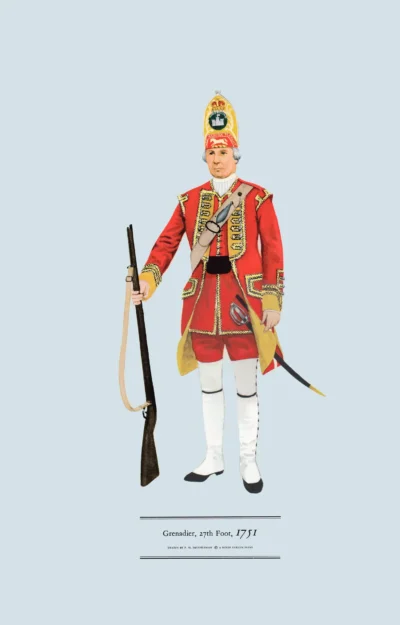Officer, 4th Foot, 1743 (King’s Own Royal Regiment)
Original price was: £18.00.£10.00Current price is: £10.00.
The King’s Own Regiment merged into the 3rd Battalion, The Duke of Lancaster’s Regiment in 2006 (scroll down for a more detailed Description)
Published 1965 by © Hugh Evelyn Limited; drawn by Colonel Philip Henry Smitherman (1910-1982), Royal Corps of Signals
Size: c. 24.5 x 37.5 cm [9 ½ ″ x 14 ½ ″] (may vary slightly from printers’ cut 50 years ago)
Printed on on medium cardstock weighing 144 g/sm2 faced in light greyish blue (RGB c. d4e1e8)
Print is STANDARD size – shipping is the same for 1 to 10 prints (based on largest print size in your order) – see Shipping & Returns.
In stock
Description
The 4th Foot were raised in 1680 as the 2nd Tangier Regiment but renamed the King’s Own Royal Regiment by King George I in 1715. It now forms part the 3rd Battalion, the Duke of Lancaster’s Regiment. This officer is shown dressed for duty. On active service he was armed with a spontoon or fusil, if an officer in a grenadier company. His coat is like that worn by privates, but with laced button-holes on lapels and ornamental slashes on the sleeves. The pockets of officers’ coats displayed much variety. [Three-cornered flaps remained on the tails of full-dress tunics until 1914 – a survival of a pocket such as this]. The full-bottomed wig has been abandoned for a neater affair: the officer’s own hair treated and powdered. This fashion persisted until about 1808. The hair on top of the head was cut and forced to grow backwards by plastering with grease. The hair at the sides was curled with tongs and the rest tied in a queue at the back with string or ribbon. Officers used to ‘˜do’ one another’s hair. To set hair well was a social accomplishment. The barber would dress it about once a fortnight. Those whose hair was too short ordered a false queue. Before a parade hair might be dressed the day before, the officer having to sleep on his face to protect his coiffure. Hair so treated must have been filthy (there is a description of the smell of soldiers’ heads in church on Sunday on a hot day).
Source: Painting of the Battle of Culloden by David Morier (1705-1770).
Additional information
| Weight | 0.0131 kg |
|---|---|
| Dimensions | 23 × 37 cm |





